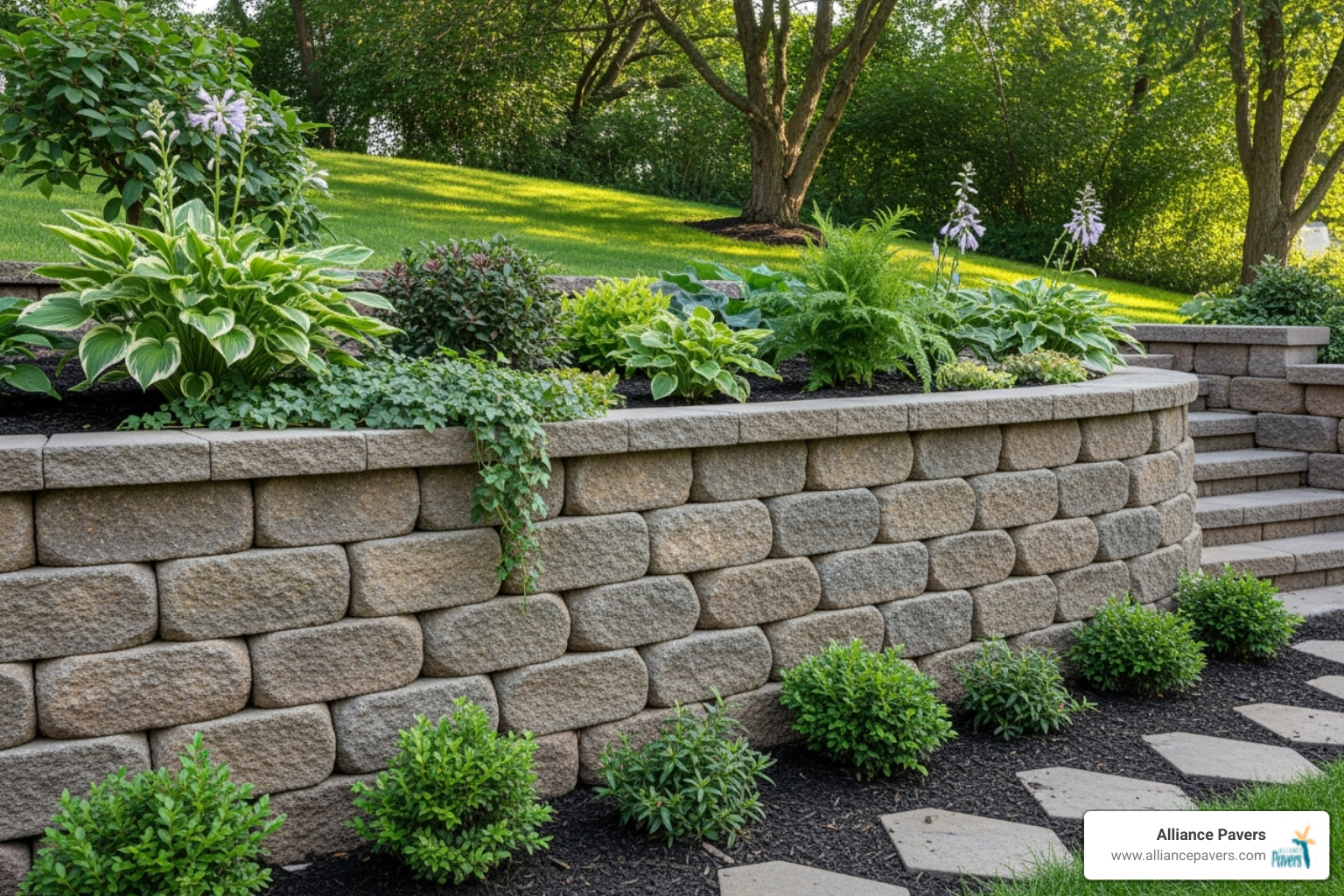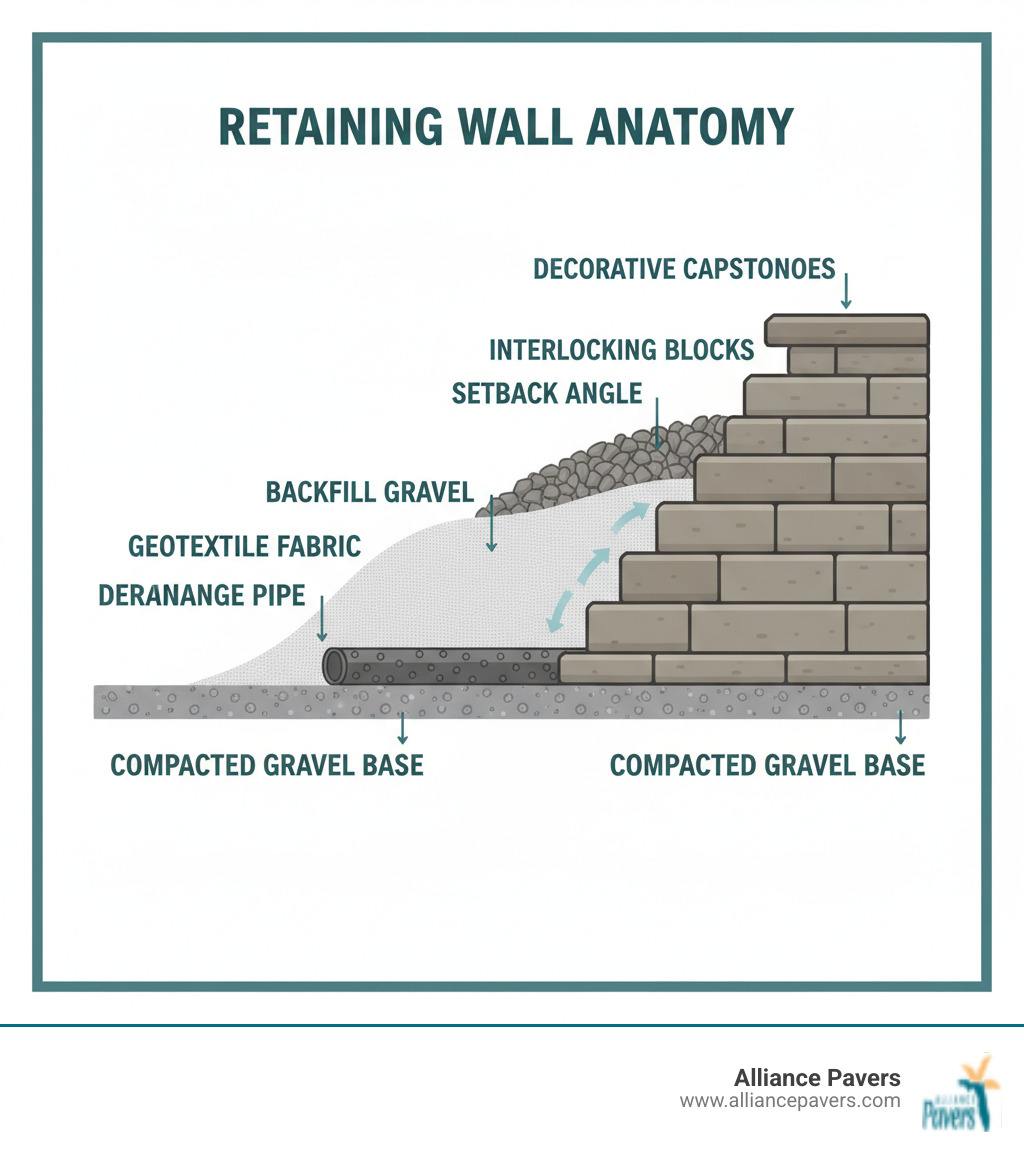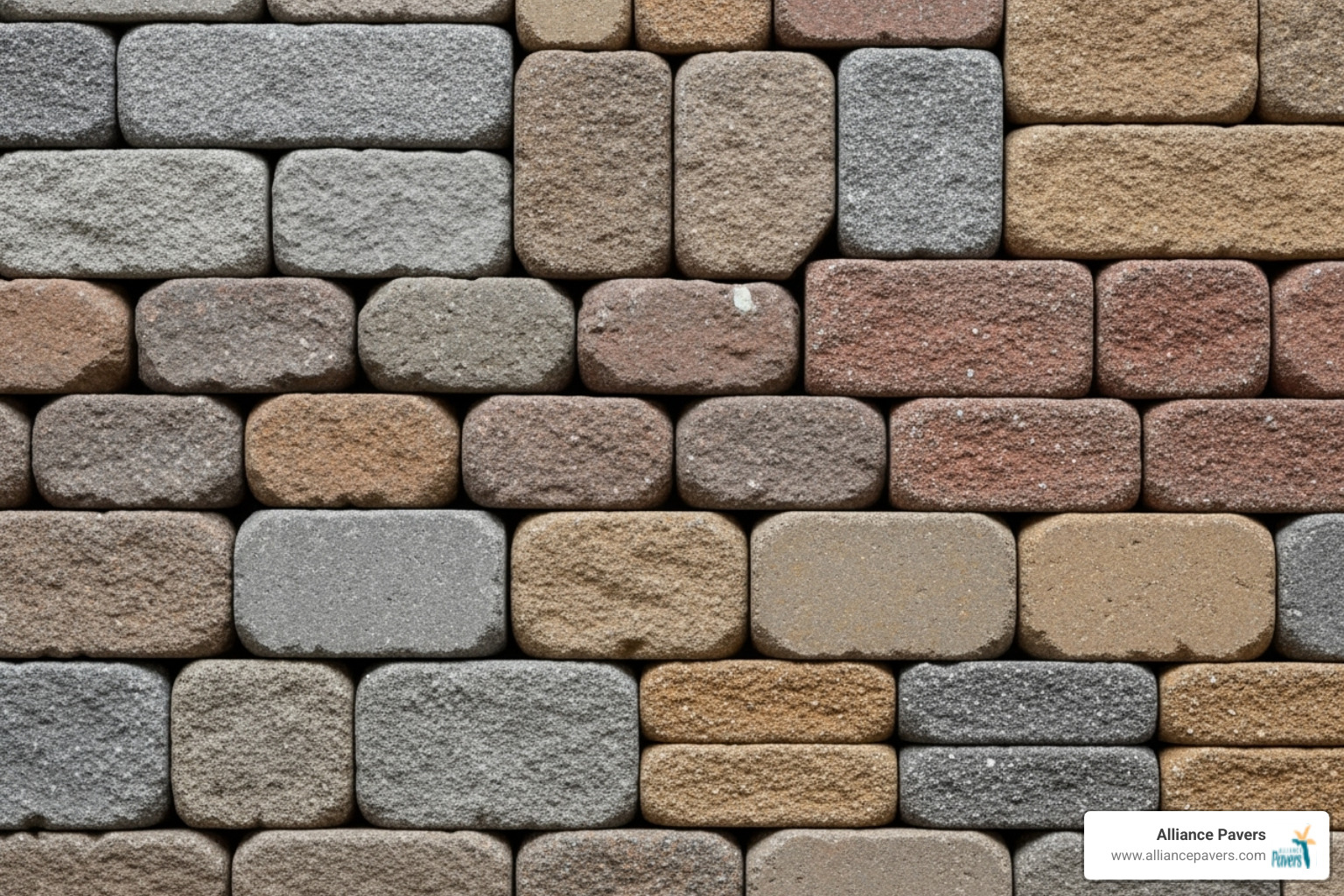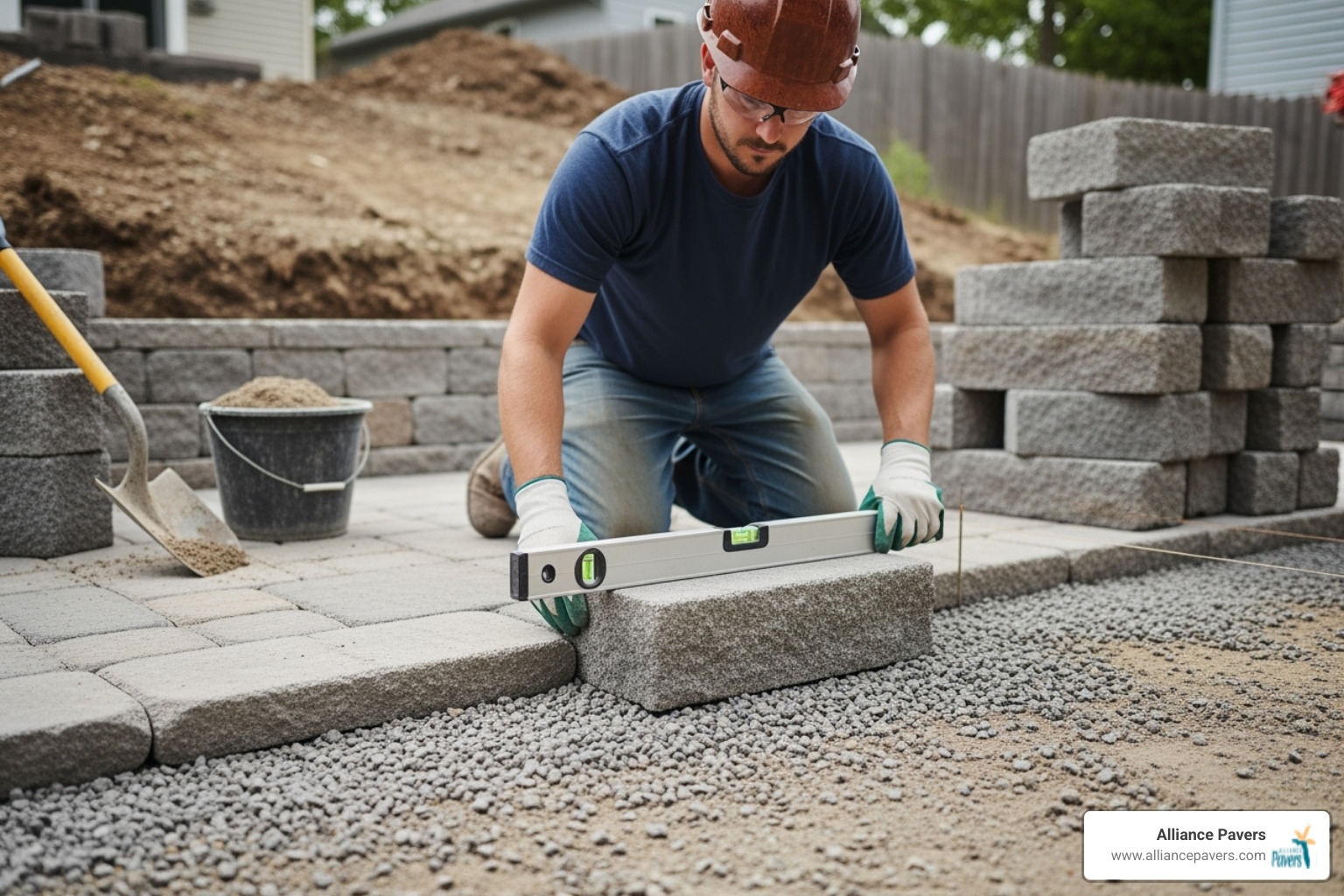
The Art and Science of Interlocking Walls
Interlocking landscaping stones retaining wall systems combine engineering strength with natural beauty, turning challenging slopes into functional outdoor spaces. These innovative systems use specially designed, mortarless blocks to create durable and attractive structures.
Key features of interlocking retaining walls:
- Interlocking mechanism: Blocks use lips, grooves, or pins to connect securely
- Gravity design: Wall stability comes from weight and proper setback
- Drainage friendly: Gaps allow water to flow through, preventing pressure buildup
- Flexible installation: Can follow curves and accommodate ground movement
- Repairable: Individual blocks can be replaced without rebuilding entire sections
Unlike traditional concrete walls, these systems offer remarkable versatility. They can transform steep slopes into terraced garden beds, create seating areas, or define distinct outdoor rooms in your landscape.
The engineering is key. Each block has a specific setback angle, leaning back into the retained soil. This creates a gravity wall that strengthens as soil presses against it. Premium interlocking blocks offer compressive strength of 5000 PSI or higher, ensuring they can withstand freeze-thaw cycles and heavy loads for decades.
For Central Florida homeowners, these systems provide excellent drainage for sandy soils and heavy rains while maintaining structural integrity. The modular design also simplifies repairs, as there's no need to demolish and rebuild if one section settles or gets damaged.

Why Choose Interlocking Stones for Your Retaining Wall?
An interlocking landscaping stones retaining wall is the smart choice for Florida homeowners looking to tackle a sloping yard or create defined outdoor spaces.
Durability is where these systems shine. Premium interlocking blocks have a compressive strength of 5000 PSI or higher. This robust construction handles decades of Central Florida's sun, rain, and hurricanes.
Their weather resistance is impressive in our climate. Unlike poured concrete, interlocking stones flex with ground movement and temperature changes. Their design manages water flow, preventing the hydrostatic pressure that destroys other walls during heavy rains.
Your property value gets a significant boost. Quality hardscaping like retaining walls generates excellent returns on investment. Buyers love functional, low-upkeep outdoor spaces.
Design flexibility is a major plus. Modern interlocking stones come in many colors, textures, and styles, from natural fieldstone to sleek contemporary lines. The modular design easily handles curves, corners, and creative layouts.
You'll appreciate the ease of repair. Individual blocks can be removed and replaced without demolishing the entire wall, unlike poured concrete.
From a sustainability standpoint, many interlocking stones use recycled materials. Permeable options are also available to help manage stormwater runoff and reduce your environmental footprint.
For deeper insights into how these walls protect your property, check out our guide on Preventing Soil Erosion with Retaining Walls.
Key Benefits of an Interlocking Landscaping Stones Retaining Wall
The real magic of an interlocking landscaping stones retaining wall becomes clear when you see how it transforms your outdoor living experience.
Soil retention is the primary benefit. A properly built retaining wall stops erosion, protecting your landscaping and preventing potential foundation issues.
These walls also create usable space from unusable slopes. A steep hillside can become level terraces for entertaining, gardening, or simply enjoying your yard.
Tiered gardens are a popular option. They create manageable, level areas on a slope, making gardening easier and more enjoyable. Each tier can feature different plants for visual interest and easier access.
The walls also excel at defining outdoor rooms. They can create a seating wall around a patio, raised planters to separate a pool area, or terraced levels to guide traffic flow.
Low maintenance requirements are a key feature. Unlike wood or metal, interlocking stones need little more than an occasional rinse and joint sand touch-ups every few years.
With a long lifespan of over 40 years, it's a lasting investment. The aesthetic appeal of stone-look blocks is timeless and complements any home architecture.
Freestanding vs. Retaining Walls: What's the Difference?
This common question affects everything from design to engineering requirements.
A retaining wall's structural purpose is to hold back earth, manage elevation changes, and prevent erosion. Due to constant soil pressure, they need substantial footings (like deep, compacted gravel bases) and careful engineering, sometimes including geogrid reinforcement.
Retaining walls are specifically designed for use on slopes, creating level areas from sloped terrain. The engineering accounts for soil weight, water saturation, and the lateral forces trying to push the wall over.
Freestanding walls, in contrast, have a decorative function on flat ground. They create visual separation, add seating, or define garden beds. Since they don't fight soil pressure, their structural requirements are simpler, needing only a stable base.
The key is understanding which type fits your situation. A steep slope needs a retaining wall, while a seating area on a level patio can use a freestanding wall.
For more technical details about different retaining wall systems and their applications, our article on Segmental Retaining Walls dives deeper into the engineering aspects.
Exploring the Types and Styles of Interlocking Stones
When creating your perfect interlocking landscaping stones retaining wall, the variety of modern options is truly exciting. Today's systems offer a range of textures, colors, and styles to complement any home, moving far beyond plain gray blocks.

Most systems use concrete blocks, but modern manufacturing creates blocks that beautifully mimic natural stone with authentic textures and rich color variations.
Surface finishes provide the variety. Tumbled stone blocks have a weathered, aged look perfect for traditional styles. For a more rugged aesthetic, chiseled face blocks replicate the appearance of hand-cut stone.
For contemporary designs, smooth finish blocks offer sleek elegance. In contrast, split face blocks have a rough, natural texture with an earthy, organic appeal that works well in naturalistic landscapes.
Color blends create walls with subtle variations that mirror natural stone, adding depth and visual interest that single-color walls cannot match.
Modular panel systems offer maximum design flexibility. They allow mixing and matching of panels, shapes, and sizes for custom looks while maintaining structural integrity.
We've had the pleasure of installing these versatile systems throughout Central Florida, including beautiful Stone Retaining Walls in Orlando, FL, where the variety of available styles allows each homeowner to create something uniquely their own.
Comparing Interlocking Landscaping Stones Retaining Wall Systems
Choosing the right interlocking landscaping stones retaining wall system means comparing options. Each type has unique strengths for different projects.
Standard concrete interlocking blocks offer great value and proven performance, lasting 30-40+ years. They resist freeze-thaw cycles and come in many colors and textures. Damaged blocks are easy to replace.
Premium architectural interlocking blocks offer superior compressive strength (often over 5000 PSI) and a lifespan of 40 years or more. They provide the most extensive design options, from smooth finishes to complex modular systems. Professional installation is often required for the best results.
The flexibility and repairability of mortarless systems are key advantages. Individual blocks can be replaced or adjusted, making long-term maintenance practical.
Modular block systems are highly versatile, suitable for everything from garden walls to large structural retaining walls. With geogrid reinforcement, they can replace traditional reinforced concrete walls, offering better drainage and easier maintenance.
From an environmental perspective, modern interlocking stones are a vast improvement. They are safe, inert, and often use recycled materials. This is a welcome change from older, creosote-treated materials that posed health risks, a topic covered by resources like the EPA's page on environmental benefits of modern retaining wall materials.
The key is matching the right system to your specific needs, considering factors like wall height, soil conditions, and design preferences. Our 25 years of experience can guide you toward the option that will serve you best for decades.
The Essential Guide to Installing an Interlocking Landscaping Stones Retaining Wall
Building an interlocking landscaping stones retaining wall combines form and function. While more forgiving than traditional masonry, success depends on careful planning and precise execution.

Interlocking systems are versatile, accommodating gentle curves or sharp corners. Planning these elements during the design phase is key to ensuring both visual appeal and structural integrity.
Wall height is a critical early decision. Walls under 3-4 feet often don't need extensive engineering requirements. Taller walls face dramatic soil pressure, making professional engineering essential for safety.
Drainage is non-negotiable for a wall's longevity. Without it, hydrostatic pressure can cause failure. Every quality installation includes a comprehensive drainage system.
For taller walls, geogrid reinforcement acts like invisible support. These synthetic grids run back into the soil, connecting the wall to the earth and dramatically increasing stability against soil pressure.
We've been perfecting these techniques for 25 years, bringing our expertise to homeowners throughout Central Florida. Our team of Retaining Wall Contractors in Orlando, FL understands the unique challenges of our sandy soils and seasonal weather patterns.
Essential Installation Steps
Installing an interlocking landscaping stones retaining wall follows a proven sequence where each step builds on the last.
Excavation involves creating a precisely sized trench for the gravel base and blocks. Getting the depth and width right from the start is crucial.
The compacted gravel base is the hero of the structure. This 6-12 inch layer of compacted, crushed gravel creates a stable, level, and free-draining foundation. Skipping this step compromises the entire wall.
Leveling the first course requires precision. These foundational blocks must be perfectly level, as any error will multiply with each subsequent course.
Stacking subsequent courses involves fitting each block into place using its interlocking mechanism. The slight setback with each course creates the gravity-fed stability that makes these walls so effective.
Backfilling with gravel occurs as the wall is built. This crushed stone creates a drainage zone behind the wall, preventing water pressure buildup.
A perforated drainage pipe is installed at the base of the backfill. It collects and directs water away from the wall, protecting your investment.
Capping the wall is the finishing touch. Capstones sit on the top course, creating clean lines and protecting the wall's integrity. We often secure them with construction adhesive.
Local building codes are important. Most municipalities require permits and engineering for walls over 3-4 feet. Check local regulations early. Resources like Permit requirements for retaining walls can provide guidance.
Long-Term Maintenance for Lasting Beauty
An interlocking landscaping stones retaining wall requires little maintenance once properly installed. A few simple practices will keep it looking new for decades.
Routine inspection is key. Annually check for settling, bulging, or shifted blocks, especially after storms. Catching issues early prevents larger problems.
Cleaning methods are simple. A sweep and rinse usually suffice. For stubborn grime, a gentle pressure wash can be used, but keep the pressure moderate to avoid damage.
Efflorescence removal handles the harmless but unsightly white, chalky deposits that can appear on concrete. Specialized masonry cleaners easily remove them.
Joint sand replenishment maintains stability and appearance. Over time, sand can wash out. Sweeping polymeric sand into the joints and activating it with water creates a durable, weed-resistant bond.
Water remains the biggest long-term threat to any retaining wall. Understanding how to spot and address drainage issues early can save thousands in repairs. For detailed guidance, we recommend reading our guide on Inspecting Your Retaining Wall for Water Damage.
Frequently Asked Questions about Interlocking Retaining Walls
After 25 years in the business, we've answered many questions about interlocking landscaping stones retaining wall systems. Here are the most common ones.
How high can you build an interlocking retaining wall?
This is a popular question. For DIY projects, we recommend keeping walls under 3-4 feet in height. Shorter walls are more manageable and often don't require an engineer's approval.
Taller walls, however, require professional design and engineering to handle the immense soil pressure. They often need geogrid reinforcement, a strong fabric grid layered into the soil behind the wall to tie the system together.
These engineering requirements are crucial. A properly designed tall wall must meet local building codes and withstand the elements. It's better to build it right the first time than to deal with a failed wall later.
Do interlocking retaining walls need a concrete footing?
Surprisingly, most interlocking retaining wall systems don't need a traditional concrete footing, which is one of their key advantages.
Instead, they sit on a compacted gravel base. This carefully prepared foundation is deep, wide, and compacted, providing excellent stability, flexibility, and superior drainage.
This flexible foundation is a major advantage. It accommodates ground shifts from freeze-thaw cycles or soil movement without cracking, unlike a rigid concrete footing. The gravel also allows water to drain, preventing hydrostatic pressure buildup.
How do interlocking blocks stay together?
Interlocking blocks stay together through a combination of physics and smart design.
The mechanical interlocking is key. Systems use rear lips, pins, or tongue-and-groove designs to create a secure connection and prevent sliding.
The weight of the blocks adds downward pressure, locking them in place. Stacking courses builds significant mass that resists movement.
Friction between blocks and against the base adds another layer of stability. The textured faces create grip that resists movement.
Most importantly, the setback design uses gravity to its advantage. Each course sits slightly behind the one below, leaning the wall into the soil. This makes the wall more stable as soil pressure increases.
Finally, the compacted backfill adds pressure that holds the wall in place. The entire system—blocks, base, backfill, and gravity—works together to create a strong, stable, mortar-free structure.
Transform Your Landscape with a Lasting Retaining Wall
In this guide, we've explored how interlocking landscaping stones retaining wall systems can transform your outdoor space. These structures blend engineering excellence with natural beauty, offering practical and stunning solutions.

The benefits are clear: decades of durability, weather resistance for Florida's climate, and design flexibility for any style. These walls create opportunities by changing unusable slopes into terraced gardens, creating functional outdoor rooms, and adding significant property value.
Their functional elegance is special. Unlike traditional concrete, interlocking stones offer easy maintenance and simple repairs. A single block can be replaced without disturbing the wall. This modularity and longevity make them a wise investment.
At Alliance Pavers, we know your landscape is an extension of your home. As a family-owned company with 25 years of experience in St. Cloud and Central Florida, we've transformed steep backyards into entertainment spaces and resolved erosion issues with beautiful, lasting solutions.
Our commitment to professional craftsmanship ensures every project gets detailed attention. We do things right the first time, using quality materials and proven techniques for a wall that will perform flawlessly for decades.
Ready to see what an interlocking landscaping stones retaining wall can do for your property? We can help you explore the possibilities and create a custom solution for your needs.
Recent Posts
Gabion Glory: Everything About Building with Slate
Paver Patio Installers Near Me: Get Your Dream Outdoor Space Today
Customer Testimonials
Hear what our satisfied customers have to say about the quality, reliability, and personal touch that set us apart.
Ready to Transform Your Home?





